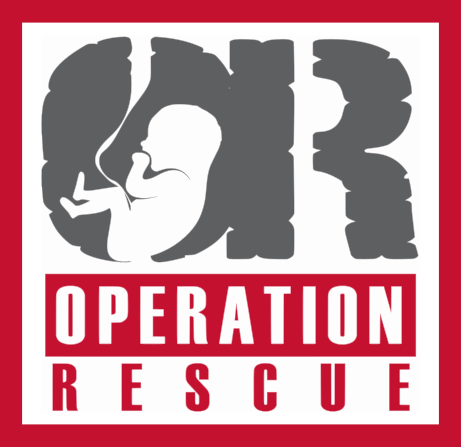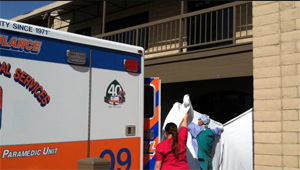Patients are still in danger from appalling conditions and practices at Texas abortion facilities — and it will only get worse!
An Operation Rescue Special Report
By Cheryl Sullenger
Austin, TX – When the Supreme Court tossed out certain provisions of a Texas abortion safety law earlier this year, in Whole Women’s Health v. Hellerstedt, it did so without considering egregious conditions that exist in Texas abortion facilities, which prompted the passage of the contested legislation in the first place.
Operation Rescue now has evidence in the form of public documents that proves 16 of 17 Texas abortion facilities miserably failed recent health and safety inspections conducted by the Department of State Health Services between August 2015 and June 2016. This information shows that Texas abortion facilities continue to pose a significant danger to the lives and health of women.
The most recent inspection reports for each Texas abortion facility were obtained from the Texas Department of State Health Services in response to Operation Rescue’s Freedom of Information Act request.
“As far as I know, these inspection deficiency reports were never submitted to the Supreme Court’s consideration. The reports show us that more oversight is needed for abortion facilities, not less,” said Troy Newman, President of Operation Rescue. “We expect conditions at Texas abortion facilities will continue to deteriorate in the wake of the Supreme Court’s errant ruling that protects abortion businesses and their sloppy, corners-cutting practices above the health and welfare of women and their babies.”
Of the 17 surgical abortion facilities in Texas that require licensing, eight are licensed as “Ambulatory Surgical Centers.” These clinics are required to meet stricter standards than the remaining nine facilities, which are licensed simply as “Abortion Facilities.”
Annual Inspections
In Texas, Ambulatory Surgical Centers and Abortion Facilities are required to submit to annual inspections. However, they do not appear to be required to pass the inspections in order to be licensed or have their licenses renewed.
Facilities are required to submit a plan of correction, but of the 17 inspection reports obtained by Operation Rescue, there is no evidence that any follow-up visit ever took place to ensure the often egregious violations were ever corrected.
Infection Control Failures
Of particular concern was a failure in 13 out of 17 facilities to ensure infection control protocols were developed and implemented to provide a sanitary environment and prevent the spread of infectious diseases.
Proper hand washing by staff, considered among the most basic and common-sense infection control measures, was an issue at several facilities. Inspectors observed clinic staff failing to wash their hands before and after the use of gloves, as required. This was particularly disturbing when the failure occurred after involvement in bloody abortion procedures, and after handling aborted baby remains.
Critical areas in many clinics were found to be unclean and/or covered with a layer of dust and debris. But it was the failure of staff to understand or practice proper sterilization techniques for surgical instruments used on women during abortions that was particularly disturbing. This had the potential to negatively impact the health of every patient that received an abortion, and in some cases, every patient that walked through the facility door.
In 10 out of 17 facilities, protocols involving testing and maintenance of the autoclave, where surgical instruments are sterilized, were not followed. There was an absence of testing in several facilities to ensure there were no biological contaminants in the autoclave or whether it reached a sufficient temperature to complete sterilization. In other cases, peel pouches that were to hold the sterilized instruments were not properly sealed.
In one facility, Southwestern Women’s Surgery Center in Dallas, tape was used to close the so-called “sterile” pouches, which were too small for the instruments they held.
This means that unsterile, contaminated surgical implements and supplies are being used on women during abortions at facilities in Texas today. This has left women subject to the spread of disease and infections.
As evidence that such infections occurred, at least one facility, the Women’s Center of Houston, was cited for the way they handled post-operative infections, which appeared to occur on a regular basis.
Overall Slothful Sanitation Practices
Citations were also issued for serious violations that existed for years, despite certification that each facility meet licensing requirements.
Some facilities had medications and supplies available for patient use that had expired years before. Others lacked policies and procedures that should have been in place prior to licensing, which were related to staff training, infection control training and protocols, and testing employees for infectious diseases such as tuberculosis and Hepatitis B.
One facility, the Suburban Women’s Center on Red Oak Drive in Houston, had a Medical Director who said he did not know his staff needed to be tested for tuberculosis and Hepatitis B, leaving patients at risk of having these diseases transmitted to them by untested staff.
That same Medical Director signed off on minutes to mandatory quarterly quality control meetings that only he attended, leaving doubt about how seriously he takes quality control. Based on the violations cited at his abortion facility, quality control appears non-existent.
He was also caught with a bottle of Morphine Sulfate in his unlocked desk drawer. He told inspectors that he opened one bottle each month and used it on several patients, but his story did not ring true. The bottle was labeled for single use. It contained no anti-microbial preservative and should have been discarded after one usage.
Other violations of note within the reports included:
• Failure to post required information where complaints could be filed against the facility. (Planned Parenthood in Dallas & Austin)
• Failure to report child abuse on a minor patient (Austin Women’s Health Center)
• Failure to observe waiting periods (Hilltop Women’s Reproductive Clinic & Reproductive Services)
• Call button for use by patients was placed out of reach of anyone who suffered a fall. (Planned Parenthood in Dallas)
• Failure to examine women prior to surgical procedures. (Planned Parenthood in Dallas & Ft. Worth, Southwestern Women’s Surgical Center)
• Cracked and/or contaminated vaginal ultrasound probe. (Hilltop Women’s Reproductive Clinic & Suburban Women’s Clinic)
• Cross-contamination of instruments/supplies with aborted baby remains. (Houston Women’s Clinic & Whole Women’s Health in San Antonio)
Need for Licensing Reform
Despite conditions and practices that are reminiscent of Kermit Gosnell’s Philadelphia “House of Horrors” abortion facility, the 16 Texas abortion facilities that failed inspections still qualified for licensing.
It is now obvious that regulatory reforms are needed to protect women from the serious health dangers posed by Texas abortion facilities. Abortion facilities should be required not only to submit to inspections, but also pass them before Ambulatory Surgical Facility or Abortion Facility licenses are issued or renewed. If the facility cannot comply, its ability to conduct abortion should be suspended for safety reasons.
It may have been beneficial for the Supreme Court Justices to have reviewed the inspection documents prior to declaring common-sense safety provisions to be an undue burden. It appears the Supreme Court’s undue burden referred to slovenly abortion businesses that complain about having to clean up. However, for women, those provisions were far from burdensome; they were protection. In fact, they were the only layer of protection they had from unsafe conditions and practices that continue to endanger them at Texas abortion facilities today – including Whole Women’s Health, the abortion business that challenged the constitutionality of Texas abortion safety law.
“It is troubling that in the wake of the Hellerstedt decision, the mainstream media continues their propaganda campaign to convince the public that abortion facilities are clean, safe, and in no need of regulation or oversight, when nothing could be further from the truth,” said Newman. “The indisputable facts are evident in the inspection records, and those facts are ugly enough to make a Billy goat puke.”
Operation Rescue has been raising the alarm about the dangers of Texas abortion facilities for years. In 2011, Operation Rescue conducted a random investigation of Texas abortion facilities that exposed serious health concerns that resulted in fines and disciplinary action against two Whole Women’s Health abortion facilities and two of their abortionists.
In 2013, Operation Rescue brought to light accusations made by former clinic workers against Douglas Karpen, a Houston abortionist, which were supported by photographic documentation. The women claimed Karpen was committing murder by twisting the necks of babies born alive during illegal late-term abortions. While a grand jury controlled by a corrupt district attorney with close ties to Karpen’s attorney failed to indict him, but the media attention on the Gosnell-life horrors contributed to the passage of HB2, the law that was considered in the Hellerstedt decision.
The chart below lists the name of each abortion facility and categories of violations that were recently discovered there. Below the chart are summaries of violations found in the inspection reports for each facility, along with links to the documents themselves.
Texas Abortion Facility Violations – Chart by Cheryl Sullenger on Scribd
AMBULATORY SURGICAL CENTERS (8)
5 Planned Parenthood facilities, 3 Independent facilities

1. Planned Parenthood
201 E. Ben White Blvd.
Austin, TX 76704
Inspection completed: December 1, 2015
Report signed by Kenneth Lambrecht, President and CEO.
View Inspection Report (8 pages).
Summary of Violations:
• For seven patients, there was no documentation that post-operative patients left the facility with a responsible adult. No operating abortionist recorded an order stating the patients could leave without the company of a responsible adult.
• Small pieces of “debris” and trash were found around the patient bed in both of the facility’s operating rooms.
• Bed foot rests in both operating rooms were covered with socks that were never changed between patients.
• Tape on the supply cart and walls (holding ammonia inhalants) rendered surfaces unable to be properly cleaned.
• Ineffective cleaning in OR areas, including the discovery of heavy dust on horizontal surfaces, including the OR lights.
• Suture kits were “sterilized” with hemostats closed, meaning that all surfaces were not properly sanitized. Other sterilization protocols were ignored, meaning that instruments used on patients were undoubtedly contaminated.
• Patient tubing and curettes were stored under the sink in OR 2 exposing them to the possibility of splash contamination.
• Open and partially used vials of lidocaine were improperly stored in the autoclave room.
• External shipping containers (considered “dirty” items contaminated with hosts of microbes) were stored on a shelf above patient care items, risking cross-contamination.
• Failed to post information telling patients how to contact the Department of State Health Services with complaints. Information posts in some areas was inaccurate.
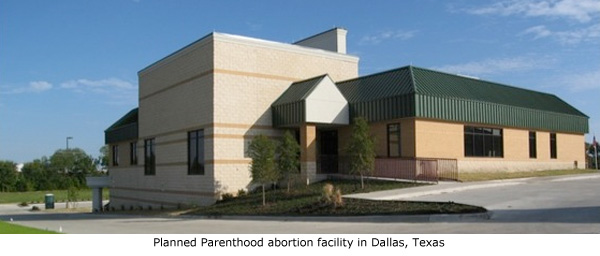
2. Planned Parenthood
7989 West Virginia Ste. 102
Dallas, TX 75237
Inspection completed: December 17, 2015
Report signed by Kenneth Lambrecht, President and CEO.
View Inspection Report (19 Pages).
Summary of Violations:
• Failed to post the Patient’s Bill of Rights in the main waiting room as required by Ambulatory Surgical Center regulations.
• Failed to include results of Physician’s physical examination in patient records. There was no record such examinations ever took place.
• Failed to have a physician or advanced practice registered nurse examine patients prior to release.
• Admitted that the abortionist never sees patients except during the procedure or in the event of a complication.
• Failure to maintain a safe, sanitary environment.
• A large circle of a dark brown substance — possibly blood — was found on the waiting room floor.
• Pre-Op call button located where patients could not reach it in the event of a fall, risking patient safety.
• Patient’s belongings stored on a bench in front of the commode.
• “Huge brown stains” on three ceiling tiles in the Post-Op bathroom.
• Patient’s snack foods stored in a box on the floor – some directly on the floor.
• No gauge on the oxygen tank.
• No preventive maintenance on the vital signs machine (last inspected 9/2014).
• Cabinet was peeling and cracking above where sterile instruments were wrapped.
• Patient supplies and sterile instruments stored in manner that could cause contamination.
• No preventative maintenance on two suction machines available for patient use.
• Cardboard boxes were found on the floor being improperly used for storage throughout facility.
• Dirty needles were found in boxes near where opened sterile patient supplies were stored.
• Mop bucket filled with dirty brown water was observed.
• No shelving in the janitorial closet. Cleaning supplies stored on floor next to the dirty mop bucket.
• Bags of clean linen stored in bags on the floor.
• Staff wore no personal protective equipment (PPE) used when handling dirty linens.
• Patients’ laundry done in the facility’s washer and dryer and handled without PPE.
• The Biohazard waste room had an unsealed cement floor that could not be adequately cleaned; posed infectious risk.
• Failed to provide safe environment: Personnel failed to wear proper operating room attire.
• Failed to wear appropriate head covers in emergency room.
• Failed to monitor conditions where sterile instruments stored, risking fire or microbial contamination.
• Failed to record Hepatitis B vaccinations for half of staff, posing the possibility that patients were exposed to Hepatitis B.
• Peel packages containing “sterile” instruments were not sealed correctly, allowing for contamination.
• Failed to store medication in a safe and secure area.
• Failure to post information on how to contact the Department of State Health Services to file a complaint against the facility.

3. Planned Parenthood
6464 John Ryan Dr.
Fort Worth, TX 76132
Inspection completed: January 20, 2016.
Report signed by Sheila McKinney, COO.
View Inspection Report (16 Pages).
Summary of Violations:
• Three of three registered nurses had no documentation that they received orientation and training to conduct conscious sedation.
• Failed to include in charts the results of physician’s physical exam for all surgical and medication abortion abortion patients.
• No procedures for surveillance techniques that could minimize infection control. No surveillance was being performed to reduce infection transmission.
• Failed to ensure a safe and sanitary environment for surgical abortion patients.
• Expired laminaria (one expired on 9/2014 and one on 4/2015).
• Three suction machines used on patients in the three operating rooms had no preventative maintenance stickers and no evidence of any preventative maintenance checks.
• Expired needles, some of which expired three years previously.
• No oxygen tank for use in emergency situations.
• Cardboard shipping box and feather duster stored next to “sterile” patient supplies.
• Clean and sterile supplies kept on a dirty floor littered with trash.
• Electrical outlet with exposed wiring and no cover posed an electrical hazard.
• Wall beside the dryer had multiple spots where the plaster was missing. Wall could not be cleaned.
• Automatic vital signs equipment with no indication if they were clean or dirty.
• Packaged food products for patients were sitting on a dust-covered cart. Two other carts were also unclean.
• No oxygen tank in the recovery room.
• Personnel failed to wear proper operating room attire, including head covers.
• Failed to maintain sterility of surgical instruments.
• “Sterile” packaging was not sealed correctly in all three procedure rooms, opening them to contaminants.
• Failed to maintain performance records for the autoclave, so no one really knew if it was working properly.
• Risk of Hepatitis B infection for other staff and all patients from four workers with unknown Hepatitis B status.
• Failed to conduct monthly inspection of fire extinguishers.
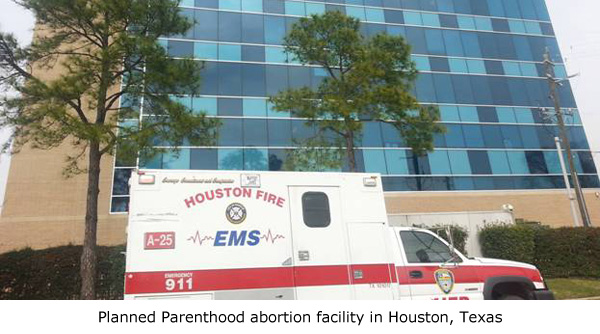
4. Planned Parenthood
4600 Gulf Freeway, Suite 300
Houston, TX 7023
Inspection completed: December 10, 2015
Report signed by Tram Nguyen, Administrator.
View Inspection Report (9 pages).
Summary of Violations:
• Staff failed to wash hands before donning gloves and between glove changes as required.
• In “Products of Conception Room,” dirty surgical instruments were washed in the hand-washing sink.
• Staff never used a measuring device for enzymatic cleaner when washing surgical instruments nor could they verbalize the required water to detergent ratio.
• Some staff had no documentation that they were ever trained in sterile instrument processing.
• Clean instrument area had packages containing cervical dilators that were contaminated with dime-sized brown splotches.
• Daily testing of autoclave for biological contamination was done in a way that invalidated the results.
• In an Operating Room, a metal stand holding a suction machine was rusty on top and bottom. (Rust cannot be disinfected.)
• After “Physician #17” conducted a surgical abortion on “Patient #6,” she removed her gloved, but did not wash her hands before reaching for a pen to write on the chart.
• “Physician #17” told an inspector that it was “kind of overwhelming” to have people watching her conduct abortions.
• A registered nurse injected “Patient #6” with medications through her IV port without first sanitizing the port. (Infection risk.)
• Failed to document the competencies of all registered nurses to provide sedation, even though they routinely administered sedation drugs.
• RN #3 never received formal training in sedation.
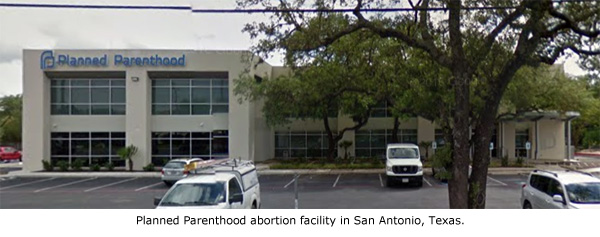
5. Planned Parenthood South Texas Surgery Center
2140 Babcock Road
San Antonio, TX 78229
Inspection completed: November 17, 2015
Report signed by Polin Barraza, RN, Vice Chair/Secretary.
View Inspection Report (2 pages).
Summary of Violations:
• Failed to have policies in place “necessary for the orderly conduct of the ASC.”
• Allowed unlicensed staff free access to the narcotics cabinet when access should have been restricted only to licensed staff that dispensed such medication.
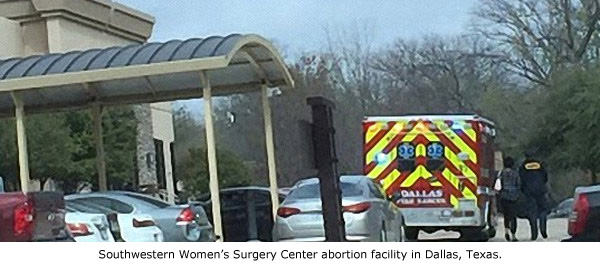
6. Southwestern Women’s Surgery Center
8616 Greenville Ave. Ste. 101
Dallas, TX 75243
Inspection completed November 24, 2015
Report signed by Jeni Beaver, Administrator.
(Facility conducts 50 suction abortions per day.)
View Inspection Report (22 Pages).
Summary of Violations:
• Biohazard room was packed floor to ceiling with bags of soiled linens and biohazard boxes. There was a refrigerator that contained aborted baby remains, but the room was so junky, that the inspector could not access that refrigerator or check its temperature.
• On the second day of the inspection, soiled linen bags were crammed into nearly every available space, including the patient recovery room. Again access to the refrigerator storing aborted baby remains was not possible.
• Failed to ensure all staff were properly credentialed, including abortionists and nurses
• One abortionist had no evidence of proper credentials, failed to sign his credentialing application, and never underwent a background check for current or past criminal conduct, as required.
• Failure to conduct a follow up appointment for some patients who took the abortion drug Misoprostol.
• Staff not properly trained to operate an autoclave or ensure surgical instruments were properly sterilized.
• No evidence of physical examinations for several surgical abortion patients before or after their procedures.
• Failed to monitor temperature patient medication refrigerator for at least three months. When it was monitored, it the temperature recorded was either below freezing or below the normal range. This was never reported to the administrator as required.
• Failure to provide a safe and sanitary environment.
• Patient linens improperly stored and prone to contamination.
• Drawer containing so-called “sterile” instruments was so full that opening it tore a hole in a package containing a vaginal speculum, contaminating it.
• Syringes were stored under the hand washing sink next to cleaning supplies.
• Patient syringes were stored in a basket near the hand-washing sink. After the inspector washed her hands, she noticed that as she reached for a paper towel to dry her hands, water dripped onto the syringes.
• Open jug of cold disinfectant that was faded and discolored with no label as to when it was opened. That disinfectant requires that the lid must be in place at all times except when in use.
• Open critical patient supplies were stored in cardboard shipping boxes, which are known to be rife with microbial contamination. The open boxes were stored on a shelf near the floor where they were subject to dust contamination.
• Cart storing “clean” linen was covered with dirt and particulate matter.
• Floor of the storage room was covered with dirt and trash.
• An O2 tank holder was dirty and laying in such a way that the filthy wheel was rubbing against paper towels used by patients and clinic staff.
• Failed to wear proper attire in the operating room, including head covers.
• Failed to monitor humidity in area where sterilized equipment was stored. Low humidity poses fire risk from electrostatic charges while high humidity poses risk of microbial growth.
• Failure to maintain the sterility of instruments.
• Surgical implements were not properly sterilized following standard protocols and some packaging was improperly closed with tape. leading to contamination.
• Instrument packets were coming out of the autoclave wet, indicating a sterilization malfunction.
• Staff lacked the training and knowledge to realize that the autoclave malfunction posed an infection-control issue.
• Autoclave logs of temperatures reached, pressures reached, length of time sterilized were non-existent.
• Failed to maintain performance records for the Manual Vacuum Aspiration equipment (consisting of a hand-held syringe used to suction the early-term baby from the womb.)
• No documentation or records to show how many times MVA syringe was used. (Must be discarded after 25-30 uses.)
• Failed to have safety checks done on a suction machine in use on patients. It had no safety inspection label.
• Both oxygen tanks were not properly secured in holders as required, creating a safety hazard.
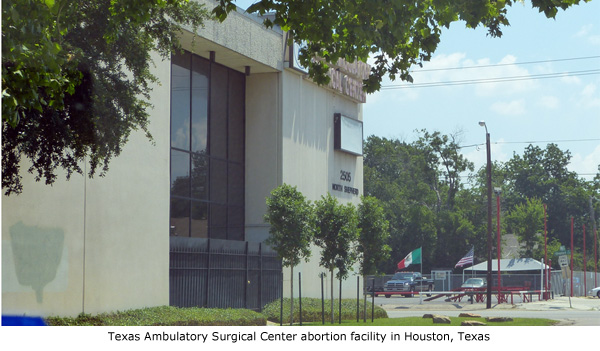
7. Texas Ambulatory Surgical Center
2505 N. Shepherd Dr.
Houston, TX 77008
Inspection completed: January 14, 2016
Report signed by Douglas Karpen, Medical Director.
View Inspection Report (7 Pages).
Summary of Violations:
• Had no RN on staff, as required for ASC licensure. No RN monitoring patients while procedures were done.
• “Dr. C” (Karpen) holds no hospital privileges. Conducted RN duties since he was not allowed to conduct abortions, but he does not hold an RN license.
• Dubiously qualified Operating Room Assistant was “trained” by Karpen, and was assisting with all surgical procedures instead of an RN as required.
• Expired medications and supplies were observed on emergency crash cart and anesthesia cart in the operating room.
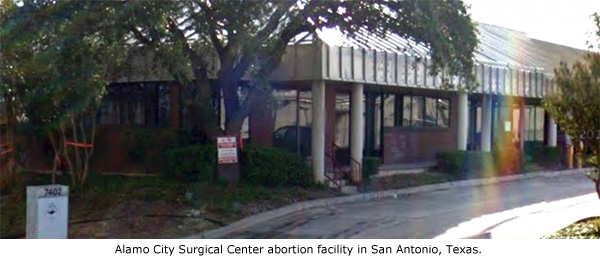
8. Alamo City Surgery Center
7402 John Smith Dr.
San Antonio, TX 78229
Inspection completed: November 24, 2015
Unsigned
View the Inspection Report (1 Page).
This was the only Texas abortion facility found in compliance.
ABORTION FACILITIES (9)

1. Austin Women’s Health Center
1902 South IH 35
Austin, TX 78704
Inspection completed: June 7, 2016
No signature.
View Inspection Report (12 Pages).
Summary of Violations:
• Failed to fully fill out DSHS Child Abuse Reporting Forms.
• Failed to report suspected child abuse for minor abortion patient.
• Failed to secure hazardous cleaning solutions and compounds, risking harm to patients
• Failed to ensure that abortion-inducing drugs were used according to FDA regulations that require women to visit the physician in person for each of the two doses. (Flouted the regulations prior to the change in FDA protocols.)
• Patients were provided Misoprostol tablets to administer themselves in violation of FDA protocols in effect at the time of the abortion.
• Failed to provide all medication abortion patients with the name and phone number of the nearest hospital to the home of the patient at which an emergency arising from the abortion would be treated.

2. Hilltop Women’s Reproductive Clinic
500 East Schuster, Building B
El Paso, TX 79902
Inspection completed: August 4, 2015
Report signed by RN, Nurse Administrator, (name redacted).
Facility owned and operated by abortionist Franz C. Theard.
View Inspection Report (9 Pages).
Summary of Violations:
• Patients living more than 100 miles from the facility did not wait two hours after having an ultrasound before their abortions took place in violation of the law.
• Six minor patients indicated on a form that they were obtaining abortions in accordance with judicial bypass procedures, but had no evidence they were ever granted a judicial bypass.
• No documentation that those minor patients received required verbal explanation of the results of their ultrasound images, as required by law.
• Failed to provide patients with the name and phone number of the nearest hospital to their homes in the event of an emergency.
• The ultrasound vaginal probe had black tape around the handle, making it impossible to sanitize. The probe was stored in a slot lined with a soggy paper towel – a prime environment for bacterial growth.
• Failed to ensure sterilization equipment was maintained and operated to ensure proper sterilization.
• Failed to conduct tests on autoclave that ensured mechanical integrity.
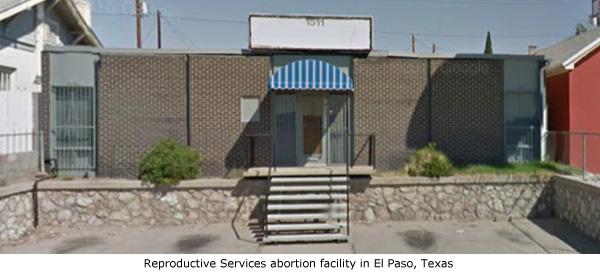
3. Reproductive Services
1511 East Missouri
El Paso, TX 79902
Inspection completed: May 25, 2016
Report signed by “Administrator,” name redacted.
View Inspection Report (8 Pages).
Summary of Violations:
Information about violations plan of correction on pages 1-2 and 7-8 were completely redacted.
• Facility failed to store hazardous cleaning solutions and compounds in a secure manner, risking patient safety.
• Failed to use sterilization process indicators in each package of instruments to be sterilized. There was no way to tell if the instruments were properly sterilized.
• Failed to comply with the 24-hour waiting period before conducting an abortion on at least one patient.
• Failed to provide patients with the name and phone number of the nearest hospital to their homes in the event of an emergency.
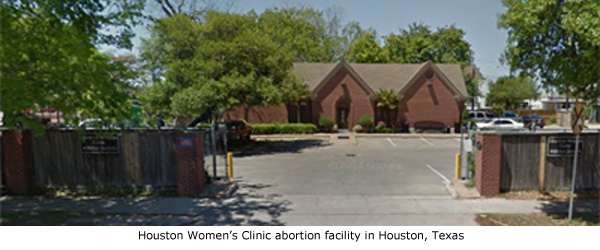
4. Houston Women’s Clinic
4820 San Jacinto
Houston, TX 77004
Inspection completed: September 23, 2015
Inspection was result of a complaint and for re-licensing
Report signed by “Medical Director,” name redacted.
Facility owned and operated by abortionist Bernard Rosenfeld.
View Inspection Report (19 Pages).
Summary of Violations:
• Failure to ensure that staff were trained and competent in sterilization protocols for surgical instruments.
• Failed to ensure a safe and sanitary environment to protect the health of the patients.
• Failed to store and administer drugs in a safe manner.
• All three procedure rooms had padded exam tables with rips and tears, making sanitizing impossible.
• One exam table had a roll of clear plastic tape stuck to it, which cannot be sanitized.
• Multiple contaminated cardboard boxes were full of patient supplies and stored in operating rooms on the floor near the exam tables posing an infection control issue.
• Bottom shelf of a cabinet in the “Decontamination Room” was filthy.
• Patient medications were stored in a drawer in the employee break room, instead of being properly secured in a locked cabinet.
• 20 pre-poured tablets of an unlabeled drug were stored in cups on the counter.
• Failed to enforce infection control policies to minimize transmission of infection by failing to date multi-dose vials when opened.
• Staff failed to wash/sanitize hands after removing contaminated gloves.
• One worker handled “products of conception” without a glove on one hand. When finished rinsing and examining tissue, the staff member removed the other glove then left the room without washing her hands.
• The same staff member then grabbed a cart used to transport the aborted baby remains to and from the operating room and pushed it into the “clean” room. When confronted, the staff member said she was “sorry.”
• Failed to keep clean supplies separated from contaminated equipment and “products of conception.” (Lacked storage space so they kept supplies like exam gloves and sanitary pads on open shelves in the same room where blood from abortions was discarded and aborted baby remains were rinsed and handled.
• Failed to maintain a log for testing that was meant to ensure the autoclave was free from biologic contamination. (Eight months since last entry.)
• Failed to follow manufacturer’s instructions on the use of disinfectant used on surgical instruments.
• Failed to maintain performance records for the two autoclaves. (Last entry nine months before.)
• Failed to provide documentation to show the two RNs were trained and competent to administer sedation.
• So-called “training” for one nurse in sedation administration included “shadowing” other nurses.
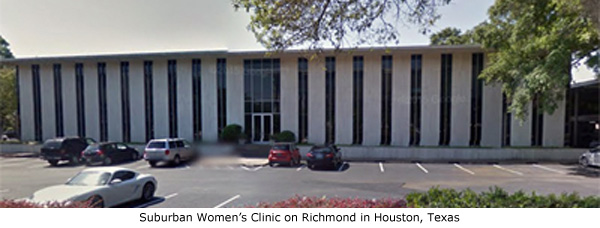
5. Suburban Women’s Clinic
3101 Richmond #250
Houston, TX 77098
Inspection completed: September 29, 2015
Report signed by “Medical Director,” name redacted. (Known to be Adebayo Jerry Adesomo)
View Inspection Report (3 Pages).
Summary of Violations:
• No orientation to job description or clinic protocols for newly hired nurse. Potential to adversely affect patient care.
• Failed to provide training for staff in child abuse identification and reporting responsibilities.
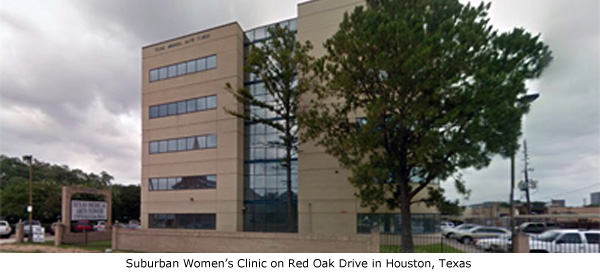
6. Suburban Women’s Clinic
17070 Red Oak Drive, Suite 505
Houston, TX 77090
Inspection completed: October 6, 2015
Report signed by “Medical Director,” name redacted. (Known to be Adebayo Jerry Adesomo)
View Inspection Report (29 pages).
Summary of Violations:
• Failure of the nurse and clinic administrator to attend mandatory quarterly quality control meetings. (Minutes signed by the Medical Director, who was apparently the only attendee.)
• Quality Assurance Committee failed to monitor infection control practices in the facility, as required.
• Quality Assurance Committee failed to monitor medication management/practices in the facility.
• Kept drugs in an unlocked cupboard in the patient’s bathroom.
• Morphine Sulfate (single use bottle) was found in a desk file drawer. Medical Director told inspectors that he opened a new bottle each month and uses it for several patients. The Morphine Sulfate was being improperly used and not diluted as necessary. It contained no anti-microbial preservatives, and therefore should have been discarded after one use.
• Staff “A” did not know how to operate the oxygen tank and suction machine in the event of an emergency.
• Suction machine tubing had been expired for six years.
• Oxygen tank leaked oxygen around the gauge.
• Failed to provide staff inoculations for Hepatitis B or tuberculosis or ensure they had been inoculated. Medical Director did not know his staff needed to be tested for the infectious diseases.
• Failed to provide staff with infection control training.
• Failed to provide a sanitary environment.
• Pooled black stagnant water was found in the bottom of the medication refrigerator.
• Dirt and dust was allowed to accumulate in the treatment area.
• Exam Room #2 had expired medical supplies, some of which expired in 2006.
• The only bottle of ultrasound gel in the facility was expired.
• Sterilization Room had 13 groups of expired patient-use items, some of which expired in 1995.
• Multiple drugs were expired in the “Emergency Medical Kit.”
• Ultrasound room had two broken ultrasound machines, dirty oxygen tank with a nasal cannula hanging from it, and a cart with contaminated shipping boxes. Everything was covered in dust.
• Below the hand washing sink in the Ultrasound Room, there were stored supplies such as exam gloves, disposable speculums, and rolls of exam table paper – all of which were at risk of contamination.
• In Exam Rooms 1 and 2, patient blue pads were stored on the floor, syringes set up for patient procedures were unlabeled, and the suction machine was covered with rust.
• Under one exam table was a contaminated yellowed hand-made tongue blade with silk tape at one end that was unraveling.
• In the Sterilization Room, instruments were unwrapped and stored on a shelf with no indication whether they were clean or dirty.
• On one ultrasound machine, the vaginal probe tip was cracked with a black substance observed inside the crack.
• Failed to have a fire extinguisher attached to the wall where one was needed. (It was sitting on the recovery area floor.)
• Staff did not know how to operate the fire extinguishers.
• Failed to maintain sterilized equipment and instruments in sealed plastic containers in 2 out of 3 procedure rooms. Those instruments included a metal speculum, metal forceps, a metal curette, and more.
• Staff failed to label peel packs of supposedly sterilized instruments with the date and load number for infection control purposes.
• Some peel packs had brown water stains on them.
• Staff failed to perform biological testing of the autoclave (sterilization machine) for bacterial growth and possible sterilization failure.
• Failed to maintain a log to note results of bacterial growth testing on the autoclave.
• Medical Director did not understand the policy for the biological testing.
• Failed to store peel packs containing sterilized equipment in a way that would prevent contamination by crushing, puncturing, or tearing.
The final citation on the deficiency report was redacted. It may have been related to care issues involving a specific patient or patients.
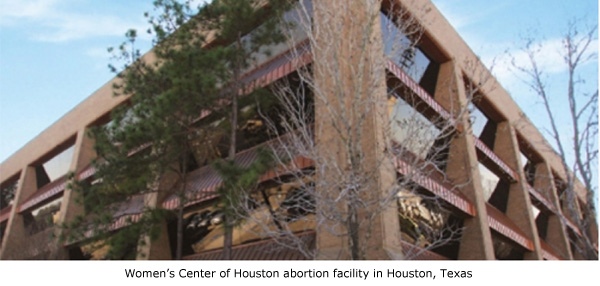
7. Women’s Center of Houston
8200 Wednesbury Lane, Suite 230
Houston, TX 7074
Inspection completed: October 27, 2015
Report signed by someone with the title of “M.D.” with name redacted. (Known to be Yuri Joseph Nosaville)
View Inspection Report (6 Pages).
This inspection report was heavily redacted. Because of the context of the redactions, it appears they were related to specific patient complications.
Summary of Violations:
• Failure to have procedures to record each patient’s condition on discharge.
• Failed to develop, implement, or review procedures for monitoring clinical records.
• Failed to develop, implement, or review procedures for monitoring post-procedure infections.
• Post-op infections from abortion at this facility did exist because one staff member explained to the inspector how those were handled, but no written policy existed as required.
• Failed to implement infection control policies to ensure instruments are properly cleaned prior to sterilization.
• Forceps and speculums were sterilized in the closed position, leaving covered surfaces unable to be sterilized. This risked infection for all patients.
• Blood was found on forceps that had already been packaged and “sterilized.”
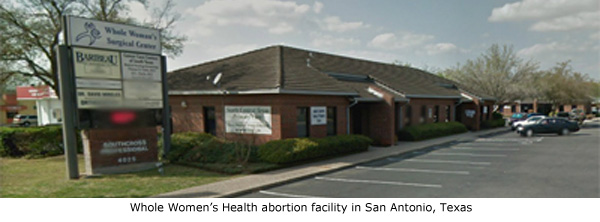
8. Whole Women’s Health San Antonio
4025 E. Southcross Blvd., Building 5, Suite 30
San Antonio, TX 78222
Inspection completed: October 21, 2015
Report signed by: “Director of Clinical Services,” with name redacted.
View Inspection Report (22 Pages).
Summary of Violations:
• Failed to ensure all staff were trained in the sterilization process for surgical instruments.
• Failed to use chemical indicators in peel pouches to ensure sterilization was being achieved.
• Failed to label instrument pouches with a date and sterilization batch.
• Failed to store “sterilized” surgical instruments in a manner to prevent tearing or puncturing of the peel pouches.
• Failure to properly maintain the autoclave (sterilization machine).
• Patient lab supplies were stored under a leaky sink in the lab room and were contaminated with a brown substance.
• One staff placed instruments to dry on a wet, contaminated counter top then placed her personal cell phone in a puddle on the counter. This contamination was not corrected.
• Blue wrap for surgical instruments was stored on the floor in a contaminated cardboard box.
• Aborted baby remains and dirty surgical instruments were processed in the same room with “clean” supplies with less than three feet separating the “dirty” area from the “clean” area. A fan was used in that room that ensured complete contamination.
• Sanitary pads for patients were stored on the dirty floor next to contaminated cardboard boxes and a biohazard container that was full of used needles.
• In the recovery room, contaminated cardboard shipping boxes full of blue pads used for patients were stored on the floor. The lid was open inviting further contamination.
• An unsecured oxygen tank was stored on the floor next to the water fountain used by patients and family members, which made it at risk of being knocked over.
• Four boxes of toilet paper and paper towels were stored on the floor in front of soiled hampers – also on the floor – in the laundry area. Three feet away, patient gowns and blankets and physician’s scrubs were stored on an open shelf.
• Three hampers marked with the Biohazard image were filled with used linens and sat among a clutter of cardboard boxes. The area was never cleaned by anyone during the two-day inspection.
• Baseboards throughout the facility were lifting and covered with a yellowish dirt.
• In the recovery room, the exam table had rust around the drawers and handles.
• In procedure room “Amelia,” the exam table was covered with rust.
• In procedure room “George,” emesis basins for patient use were stored improperly under the sink and were at risk of contamination.
• The suction machine had lost its bumper and was covered with dust.
• Ceiling tiles exhibited signs of water damage.
• Crash Cart in the hallway was covered in dust.
• Failure to keep records related to the usage of Manual Vacuum Aspiration equipment (a syringe used in early abortions). There was no record how many times it had been used. MVA syringes can only be used 25-50 times before they must be discarded.
• Multiple MVAs were stored on the counter at the nursing station in an open container with no lid. Another MVA was lying on a contaminated cart with no cover.
• Staff member responsible for the autoclave failed to conduct proper testing or log the necessary records related to testing and maintenance.
• Failed to discard medication in a timely manner. One syringe of Lidocaine used the previous day was still laying around.
• Failed to follow manufacturer’s instructions for use of cold disinfectant, compromising the cleaning process.
• No disinfectant log was kept as required.
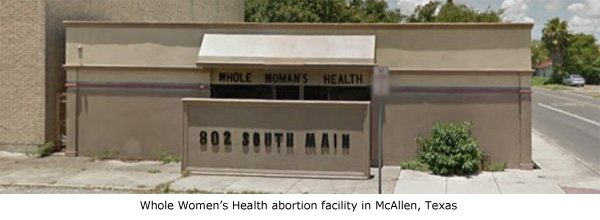
9. Whole Women’s Health of McAllen
802 South Main Street
McAllen, TX 78501
Inspection completed: November 10, 2015
Report signed by “LVN, Clinic Administrator,” with name redacted.
View Inspection Report (7 Pages).
Summary of Violations:
• Failure to provide health care in a safe, sanitary environment.
• Remains of aborted babies were stored in plain Ziploc bags in the freezer and were not labeled.
• In the sonograph room, the vinyl cover on the exam table was torn and could not be properly disinfected.
• Medications on the emergency cart were expired.
• Expired medications elsewhere in the facility were still being used on patients.
• One suction tube package was contaminated with brown substance, while another was in torn packaging, compromising its sterility.
• Hazardous cleaning solutions were not secured or stored properly.
• Failed to store sterile surgical instruments in peel pouches in a way that would prevent the pouches from being punctured or torn and therefore contaminated.
• Peel packages were not properly sealed to prevent contamination.
• Failed to ensure that all patient care personnel were certified in CPR and competent to administer it. This was a direct patient safety issue.
